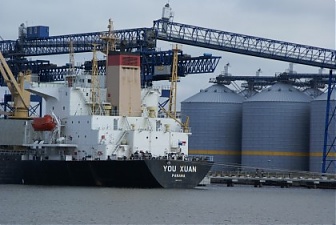Energy, Latvia, Port, Transport
International Internet Magazine. Baltic States news & analytics
Friday, 26.04.2024, 00:46
Cargo handled by Latvian ports down 29.7% in 8 months
 Print version
Print version |
|---|
In the first eight months of this year, Latvian ports mostly transshipped bulk cargo – 13.727 million tons (42.6% less than a year ago). This included 2.827 million tons of coal (77.3% decrease), 2.967 million tons of grain and grain products, which is a decrease of 4.2%, 1.366 million tons of wood chips (9.7% up), and 1.354 million tons chemical bulk cargo (down 15.9%).
Liquid cargo turnover at Latvian ports decreased 15.8% to 8.088 million tons. Oil products accounted for most liquid cargo handled by Latvian ports – 7.658 million tons, down 15.1% on year.
Handling of general cargo was down 9.9% on year to 7.929 million tons in the first eight months of 2020.
Handling of containerized cargo decreased 5.8% on year to 3.081 million tons, timber cargo dropped 16.7% to 2.506 million tons and roll on/roll off cargo fell 10.4% to 2.017 million tons.
Riga Port was the largest Latvian port in terms of cargo turnover in the first eight months of this year, handling a total of 15.819 million tons of cargo (26% decrease year on year), followed by Ventspils Port with 8.776 million tons (41.5% reduction) and Liepaja Port with 4.002 million tons (14% decrease).
Skulte was the leader among Latvia's small ports with cargo turnover at 647,400 tons (9.9% decrease on the first eight months of 2019), followed by Mersrags Port – 263,200 tons (18.7% down), and Salacgriva Port – 196,800 tons (13.6% down).
The total cargo turnover of Latvia's small ports in January-August was 1.147 million tons, a decrease of 12.6% on the first eight months of last year.
In 2019, Latvian ports handled 62.379 million tons of cargo, which was 5.7% less when compared to 2018.
- 28.01.2022 BONO aims at a billion!
- 25.01.2021 Как банкиры 90-х делили «золотую милю» в Юрмале
- 30.12.2020 Накануне 25-летия Балтийский курс/The Baltic Course уходит с рынка деловых СМИ
- 30.12.2020 On the verge of its 25th anniversary, The Baltic Course leaves business media market
- 30.12.2020 Business Education Plus предлагает анонсы бизнес-обучений в январе-феврале 2021 года
- 30.12.2020 Hotels showing strong interest in providing self-isolation service
- 29.12.2020 В Латвии вводят комендантский час, ЧС продлена до 7 февраля
- 29.12.2020 В Rietumu и в этот раз создали особые праздничные открытки и календари 2021
- 29.12.2020 Latvia to impose curfew, state of emergency to be extended until February 7
- 29.12.2020 Linde Gas открывает завод в Кедайняйской СЭЗ








 «The Baltic Course» Is Sold and Stays in Business!
«The Baltic Course» Is Sold and Stays in Business!

